Time Machine - Troubleshooting
A9. Information needed to diagnose a problem
Time Machine - Troubleshooting
A9. Information needed to diagnose a problem
If you're having a problem with Time Machine, it's a good idea to help those trying to diagnose it by supplying important information about your system and the problem.
Don't worry if you have trouble finding or supplying some of this -- if it's needed, whoever's helping you will ask for it.
Some guidelines about what's important:
System Information:
•OSX Version
•Type of Mac
•What's being backed-up
•Backup Location
If you're not sure how to find any of that, or just what to report, see the green box below.
Problem Information:
•Type of problem (setup; backups don't run, hang, or fail; viewing or restoring backups)
•Frequency - intermittent or always?
•Details - varies by type of problem, of course. Does it happen in a different user account? If it's a backup problem, is it the first backup? See the blue box below for more.
•Messages any messages sent (screenshots are fine)
If you're not sure how to find or post such info, see the blue box below.
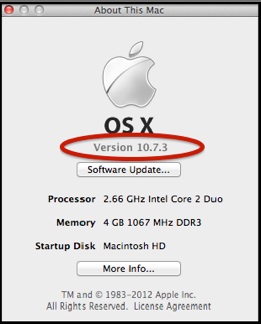
OSX Version - a number, formatted 10.n.n
To find it, click the Apple icon at the upper left of your screen, and select About This Mac. The resulting window shows the version number (10.7.3, in the sample).
Note: the second number indicates the "major" or "named" version -- 5 is Leopard, 6 is Snow Leopard, 7 is Lion, 8 is Mountain Lion.
Type of Mac such as MacBook Pro, iMac, MacBook Air
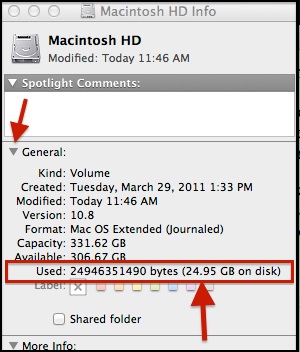
It's usually named Macintosh HD. To see how much data is on it, click Go in a Finder menubar (or your desktop) and select Computer. In a moment, you'll get a display showing all the disks/partitions in or connected to your Mac.
The internal HD will have a gray icon. If there's more than one, you want the one with the same name as the Startup Disk in the sample above. Control-click (right-click) it and select Get Info. The resulting window will show the amount Used in the General section (if you don't see it, click the little triangle before the word General). All we need is the nn GB figure.
If any other drives are being backed-up, how much data is on them? Use Get Info to find out.
Backup Location - specify which type, and details (if possible):
•External HD - size, make, whether it has it's own power plug, approximate age
•Time Capsule - size, how your Mac is connected to it (Ethernet cable or wireless), approximate age
•External HD attached to a Time Capsule, Airport Extreme, or Other Mac - specify which, details about it as above, and how your Mac is connected (Ethernet cable or wireless)
•Network (NAS or Network Attached Storage) Drive - make, approximate age, how you're connected (Ethernet cable or wireless),
•Internal HD - size
For all destinations, is other data on the destination (if so, how much, if you know?)
Problem Information
Details
•Backups don't run - under what circumstances? Manual or automatic? Are there any messages? If so, see Messages below.
•Backups hang - always at the same place? There should be messages on the Time Machine Preferences panel (or by clicking the Time Machine icon in your menubar) while a backup is running, showing the progress, like "xxx GB of yyy GB." If the xxx is always the same, that may be a clue.
•Backups fail - does it happen always, or occasionally? Is this the very first backup to this destination, or have other backups completed ok? If any messages are sent, see below.
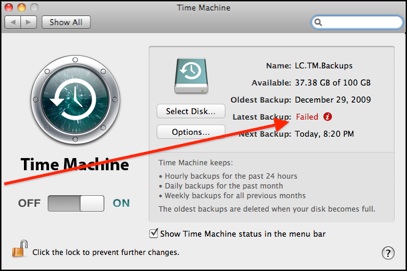
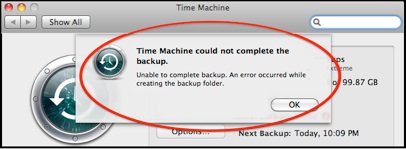
(Section #C2 lists the most common ones, with links to ways to fix them.)
To make a screenshot, press
Shift+Cmd+4. That will put a "target" on the screen; drag it over the part of the screen you want to copy. When you release, the screenshot will be made and appear on your Desktop.
To post a screenshot in the Apple Support Communities forum, click the camera icon in the toolbar above the entry box to select the file you want.
Log Messages - sometimes it's helpful to get the messages from the logs your Mac keeps, such as, if the problem is a failing backup. See section #A1 for a handy widget that will display the Time Machine messages from your logs.
RUNNING TIME MACHINE Diagnostics:
Note: this is rarely required or useful. Do not use it unless asked, for a specific purpose. It's included here only for convenience.
Turn Time Machine OFF, but keep the backup destination selected on the Preferences window.
If your backups are on a Time Capsule or network, connect to it, but obviously don't do any backups.
Open the Terminal app (in your Applications/Utilities folder). Be very careful with this app. It's a direct link into UNIX, the underpinnings of OSX, but without the protections of OSX.
In Terminal, the prompt looks like this: <Computer Name>:~ <your name>$
(where <your name> is your short user name). It's followed by a non-blinking block cursor.
Copy and paste the following after the prompt:
sudo tmdiagnose -f ~/Desktop
and press Return. You'll be prompted for your Admin password (which won't be displayed). Press Return again.
You'll see an explanatory note, then press Return again to actually run the diagnostics.
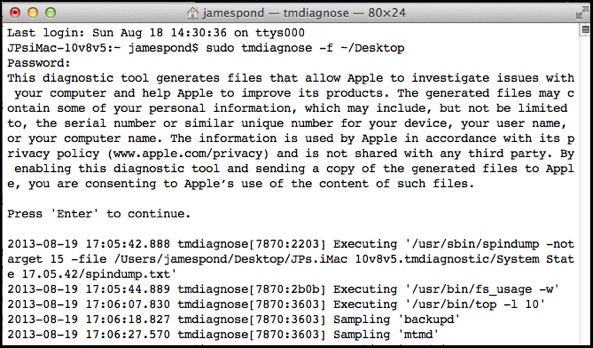
When it's done, it will put a zip file on your Desktop containing all the output.
Feel free to open it (double-click) and examine the contents.
It's mostly gibberish to us mere mortals, but does contain some identifying information, such as your short user name (home folder name). If you're not comfortable sending anything you see there, don't.